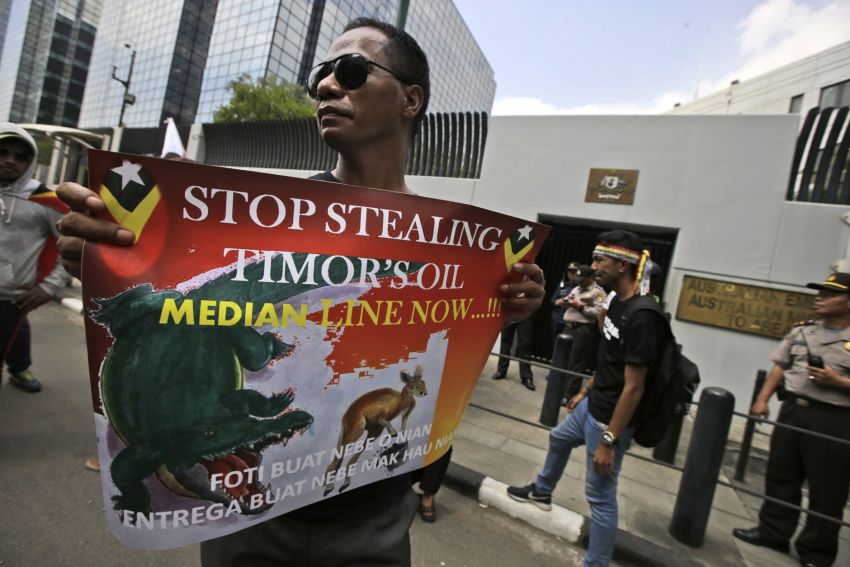
East Timor has taken Australia to the United Nations Conciliation Commission at the Permanent Court of Arbitration in The Hague under the United Nations Convention on the Law of the Sea (UNCLOS).
At issue is a permanent maritime boundary and the exploitation of oil and gas reserves in the Timor Sea — with East Timor accusing Australia of stealing badly needed resources that, by international law, belong to Asia’s poorest nation.
In hearings that began on August 29, East Timor is arguing for the maritime boundary to be fixed at the median line between the two countries, as provided for by UNCLOS and other international law.
Australia is arguing that it has a right to retain the lion’s share of East Timor's hydrocarbon resources under unequal treaties forced on East Timor through espionage and subterfuge. Such treaties also took advantage of the economic weakness of East Timor created by the devastation of Indonesia’s illegal 1975–1999 occupation, which Australia supported.
Shortly after East Timor became independent in 2002, Australia announced it would no longer consider itself bound by judgements on boundary disputes under UNCLOS or at the International Court of Justice. This means it can legally ignore the Conciliation Commission's findings.
“We have not come to The Hague to ask for favours or special treatment,” East Timor's head negotiator, former President and Prime Minister Xanana Gusmão told the hearing on its opening day.
“We have come to seek our rights under international law. So many East Timorese people have fought and died for our sovereignty.”
Australia was the main diplomatic supporter of the genocidal Indonesian occupation, which killed up to 300,000 Timorese — about a third of the population. The reason for this support was explained in an August 1975 diplomatic cable from then-Australian ambassador to Indonesia Richard Woolcott.
The cable stated bluntly that Australia could gain a more lucrative deal for the Timor Sea oil with Indonesia than an independent East Timor. The 1989 Timor Gap Treaty, illegally signed between Indonesia and Australia, proved this assessment correct.
“The image of the Australian and Indonesian foreign ministers flying over the Timor Sea while drinking champagne to celebrate the signing of the Timor Gap treaty filled us with much sadness,” Gusmão said.
Australian politicians, trying to prove that Australia has helped East Timor, make much of Australia’s despatch of peacekeeping troops in 1999. But what this self-congratulation ignores is that when the Indonesian government allowed a referendum in East Timor, Australian intelligence was aware that the Indonesian army, and the militias it created, were planning a massacre should East Timor vote for independence.
Yet Australia lobbied to ensure the Indonesian military was kept in charge of “security” before and after the UN-supervised vote.
Australian soldiers were sent and Indonesian forces withdrew without firing a shot after three weeks of widely publicised violence. About 1400 Timorese civilians were killed in the violence and 70% of the nation's infrastructure destroyed.
Timorese activists said Australia used the delay to pressure East Timor’s leaders to accept the continuation of the Timor Gap Treaty’s provisions on oil and gas. East Timor was weakened in negotiations by the desperate need for revenue.
Gusmão told the UN Conciliation Commission that Australia took advantage of the devastation. He described the Timor Sea Treaty (TST), signed in 2002, as a “mirror image” of the 1989 treaty with Indonesia.
The TST gave East Timor 90% of royalties from the Bayu-Undan gas field, yet Bayu-Undan is closer to East Timor than Australia. The agreement also allows the gas to be piped to Darwin, giving Australia exclusive rights to tax gas from the pipeline.
A second treaty in 2006, the Treaty on Certain Maritime Arrangements in the Timor Sea (CMATS), split revenues from the Greater Sunrise oil field 50–50 and deferred the issue of a permanent maritime boundary for 50 years.
East Timor rejected CMATS as illegitimate in 2013 after it was revealed that the Australian intelligence outfit, ASIS, was bugging the East Timorese government and negotiating team during the treaty negotiations.
“We were not aware at the time, that under the cover of an Australian program renovating Timor-Leste government offices, Australia installed listening devices to spy on the Timorese officials to maximise their advantage and commercial interest,” Gusmão said.
Australia's response to the revelations was to send domestic intelligence agency ASIO to raid the office of the Canberra lawyer of the Timorese government, seizing documents. The ASIS whistleblower who revealed the espionage was placed under house arrest, preventing them from testifying in The Hague.
Australian foreign minister Julie Bishop put her government's case in an August 30 opinion piece in The Australian: “CMATS provides for an even split between Australia and East Timor from the Greater Sunrise field, despite 80% of the disputed area lying in an area of exclusive Australian seabed jurisdiction.”
Her definition of “exclusive seabed jurisdiction” is not shared by international law. Greater Sunrise, like Bayu-Undan, lies on the Timorese side of the median line.
“East Timor has made admirable gains in poverty reduction,” Bishop said. “It has done so largely on the back of oil and gas profits, which account for about 95% of government revenue.”
It is true that 95% of Timorese government revenue comes from oil and gas, but poverty has not reduced. This year a climate-change induced drought has in fact worsened it. “Almost 50% of households across the country are expected to experience varying levels of food insecurity,” the Red Cross reported in May.
Bishop also made the standard self-congratulatory remarks about “generous” Australian aid. However, Timorese civil society group La’o Hamutuk has pointed out that the US$5 billion illegally obtained by Australia since 1999 from oil and gas revenues that rightfully belongs to East Timor is at least $3 billion more than Australian aid to East Timor.
Like the article? Subscribe to Green Left now! You can also like us on Facebook and follow us on Twitter.